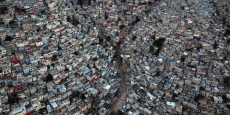

Haiti Earthquake
Before the earthquake
Haiti was 145th of 169 countries in the UN Human Development Index, which is the lowest in the Western Hemisphere
More than 70% of people in Haiti were living on less than $US2 per day
86% of people in Port au Prince were living in slum conditions - mostly tightly-packed, poorly-built, concrete buildings.
80% of education in Haiti was provided in often poor-quality private schools, the state system generally provided better education but provided far too few places
Half of people in Port-au-Prince had no access to latrines and only one-third has access to tap water
Relief (the earthquake was on Tuesday January 12th)
Days 1-3 – Rescue efforts began in the immediate aftermath of the earthquake, with able-bodied survivors extricating the living and the dead from the rubble of the many buildings that had collapsed.
From 12 January, the International Committee of the Red Cross focused on bringing emergency assistance to victims of the catastrophe, in close cooperation with its partners. International rescue efforts were restricted by traffic congestion and blocked roads. Although US Secretary of Defense Robert Gates had previously ruled out dropping food and water by air as it is too dangerous.
Nations from around the world sent personnel, medicines, materiel, and other aid to Haiti. The first team to arrive in Port-au-Prince was ICE-SAR from Iceland, landing within 24 hours of the earthquake. A 50-member Chinese team arrived early Thursday morning. From the Middle East, the government of Qatar sent a strategic transport aircraft (C-17), loaded with 50 tonnes of urgent relief materials and 26 members from the Qatari armed forces, the internal security force (Lekhwiya), police force and the Hamad Medical Corporation, to set up a field hospital and provide assistance in Port-au-Prince and other affected areas in Haiti. A rescue team sent by the Israel Defense Forces' Home Front Command established a field hospital near the United Nations building in Port-au-Prince with specialised facilities to treat children, the elderly, and women in labor. It was set up in eight hours and began operations on the evening of 16 January.
Days 4-7
By 16 January, US helicopters were distributing aid to areas impossible to reach by land. The Canadian navy vessel HMCS Halifax was deployed to the area on 18 January; the Canadians joined Colombian rescue workers, Chilean doctors, a French mobile clinic, and Sri Lankan relief workers who had already responded to calls for aid. British search and rescue teams were the first to arrive in Léogane, the town at the epicenter of the quake, on 17 January. The Canadian ship HMCS Athabaskan reached the area on 19 January. Over the first weekend 130,000 food packets and 70,000 water containers were distributed to Haitians, as safe landing areas and distribution centers such as golf courses were secured.
There were nearly 2,000 rescuers present from 43 different groups, with 161 search dogs; the airport had handled 250 tons of relief supplies by the end of the weekend. Reports from Sunday showed a record-breaking number of successful rescues, with at least 12 survivors pulled from Port-au-Prince's rubble, bringing the total number of rescues to 110.
image- https://www.france24.com/en/20181007-several-killed-haiti-earthquake-porte-paix

0 Comment:
Be the first one to comment on this article.